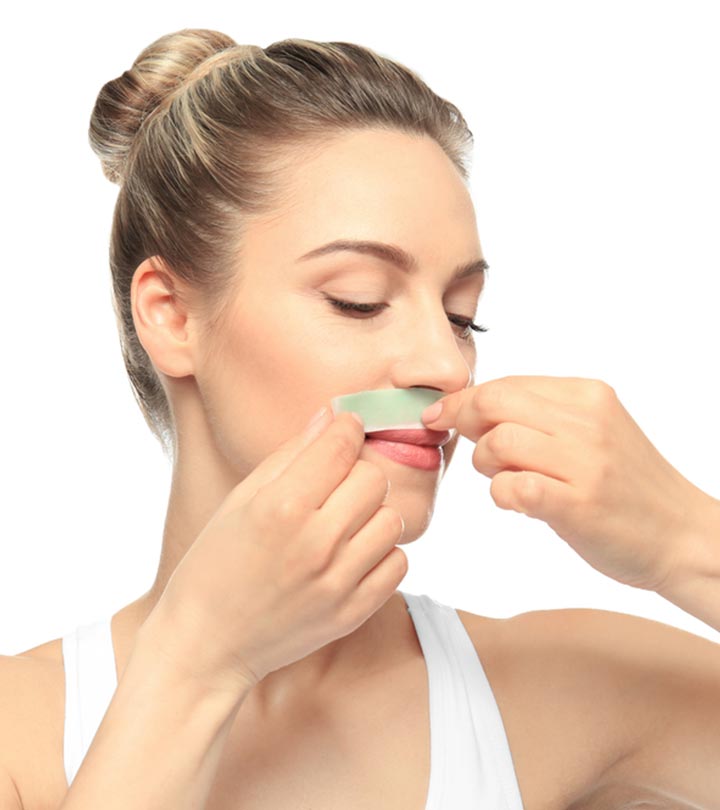Facial waxing is preferred by many to avoid using razors on the face. However, most people might be unaware of the side effects of face waxing. Though it is considered safe, it may cause redness, rashes, pain, and ingrown hairs if not done carefully. This article discusses the side effects of facial waxing and prevention tips. Keep reading to learn more.
Fun Fact In ancient Egypt, a smooth, hairless body defined beauty. Both women and men used a mixture of sugar, honey, and oil to remove the body and facial hair.
In This Article
The Side Effects Of Facial Waxing
1. Is Painful
Shutterstock
Pulling out the peach fuzz is indeed painful! However, it also depends on your skin type, the type and brand of waxing products, the hair density on your face, the pain tolerance levels, and the area you are waxing. Usually, waxing the upper lip or sensitive skin can be painful.
2. May Cause Rashes
This is a common side effect of facial waxing. The facial skin is delicate compared to the skin on your body. Waxing may cause temporary irritation and fluid-filled blister-like rashes. If the rashes do not go away after 2-4 days, consult your dermatologist. Also, avoid waxing your face and switch to other hair removal techniques.
3. May Cause Redness And Inflammation
Facial waxing may cause mild redness and inflammation with a burning or stinging sensation. Freshly waxed skin is sensitive to touch, and these symptoms should subside within a few hours. Apply a soothing gel or cream to your face immediately after waxing. Consider using an over-the-counter hydrocortisone cream if you are experiencing redness or irritation. Avoid using products with harsh chemicals for a few days.
Related: Home Remedies To Reduce Redness On The Face | Prevention Tips
4. May Cause Ingrown Hair And Bumps
Shutterstock
If the hair is not removed from roots, it may cause ingrown hairs and bumps on your face. Ingrown hairs occur when the hair shaft breaks or is shaved just below the skin surface, and the hair grows back into the skin instead of outwards of the skin’s surface. These may appear like inflamed bumps after a week of waxing. They can be painful and can cause itching and inflammation.
5. Slight Bleeding
The hair follicles are connected to blood vessels. When you wax and rip the hair out, you may see tiny blood droplets oozing from the pores. This type of trauma is common during waxing. In case you observe abnormal or continuous bleeding, consult your doctor.
6. Adverse Reactions
Shutterstock
Face waxes can cause allergic reactions. You may experience hives, itching, and rashes. Do a patch test to prevent this.
Also, waxing tanned or sunburned skin is not a good idea. It may cause sensitivity and breakouts on the waxed area. Usually, facial waxing does not cause any scars. However, if not done the right way, it may peel the top layer of the skin and cause scarring. Hence, take extra care while waxing your face. Here are a few tips to prevent any such side effects.
Related: Sunburn Vs. Sun Poisoning: An Overview
How To Prevent The Side Effects Of Facial Waxing
iStock
- Never use body waxes on your face. They may burn or bruise your skin.
- Always read the instructions on the product labels before using facial wax.
- Avoid waxing wounded skin, rashes, or active breakouts to prevent infections.
- Avoid facial waxing if you have sunburnt, dry, or sensitive skin.
- Do not opt for facial waxing if you have recently undergone laser treatment.
- Avoid facial waxing if you are using any prescription topical treatments for acne, age, and dark spots.
StyleCraze Says An alternative to face wax is a dermaplaning treatment, where a fine blade is used to remove hair and improve skin texture. You can also get a laser bleach treatment.
Here are a few more tips to keep your skin protected during facial waxing.
Related: 10 DIY Coffee Scrub Recipes To Try At Home For Smoother Skin
Tips For Facial Waxing
iStock
- Exfoliate your face a day before waxing to clear all dirt and pollutants. It will help hair make its way through your skin and smoothen the waxing process. Remember to use light, non-harsh scrubs to avoid making the skin more sensitive.
- Post waxing, apply a cold (not frozen) pack to your face for at least 20-30 minutes to reduce pain and inflammation. It should be above 4°C. Applying a soothing gel may also help ease the discomfort.
- When using hot wax, check its temperature before application to prevent burning your skin. You may also test the wax temperature by applying a dab of the wax to the inside of your wrist to make sure it is at a comfortable spreading temperature.
- Always spread the wax evenly and pull it in the direction of the hair growth. This helps the wax adhere properly (for better results) and prevent ingrown hairs and bumps.
- Follow a proper skin care routine and apply face serum a night before doing facial wax.
StyleCraze Says Wrap a few ice cubes in a cotton cloth and dab on the irritated skin after waxing for a soothing effect. Also, avoid heat exposure, like steaming, saunas, or the sun, for 12-24 hours.
Face waxing removes facial hair quickly, leaving you with silky, smooth skin. Waxing sensitive facial skin, on the other hand, may also cause minor discomfort and inflammation. Preparing your skin for waxing and caring for it afterward can be as simple as following the recommendations in this article. If you have sensitive skin, you should seek professional assistance. They can help you determine the ideal for your skin type and use the most effective treatments with the fewest adverse effects. We wish you a pain-free and effective waxing session on your next appointment!




